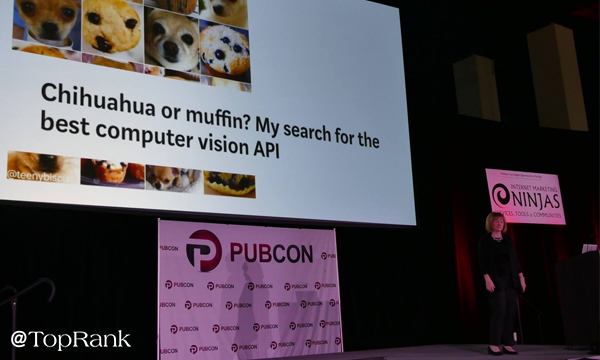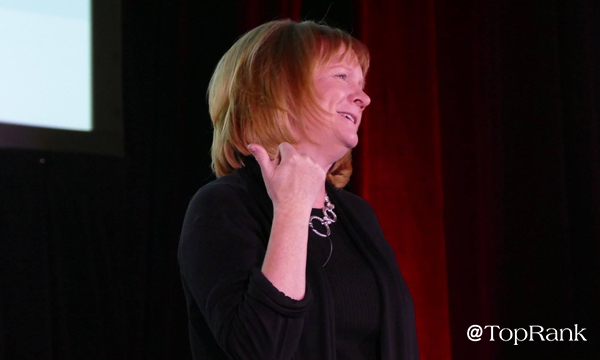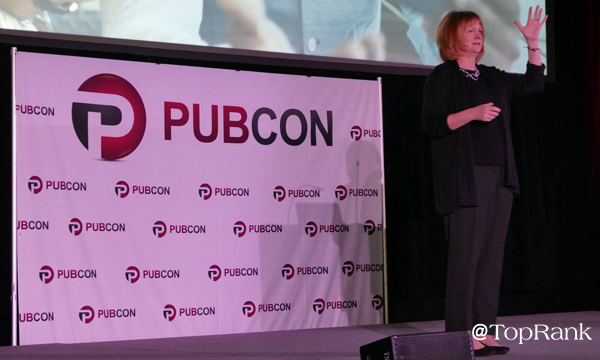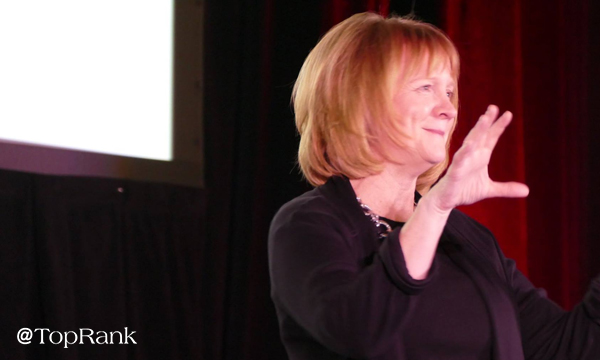
Debra Jasper, founder of Mindset Digital, practices what she preaches when it comes to delivering engaging messages in eight seconds or less, as she demonstrated during an energetic mile-a-minute “You Have 8 Seconds – GO! “ Pubcon Pro Las Vegas 2018 keynote address.
Before Debra took the stage, Pubcon founder Brett Tabke told the audience how one of her previous keynotes holds the record as the conference’s highest-rated, and her latest presentation showed no sign of letting go of that title.
Walking The Walk With 367 Slides
Debra’s keynote explored how to effectively get your message out in a world where today’s professional has just an eight-second attention span, and she hit the ground running, flying through some 367 visually interesting slides, nearly all featuring motion or video.
She began by encouraging us to form the kind of good digital habits that will help break through the ever-present digital noise today, and asked what Google was like in 1997, soon pointing out the trick question — Google began a year later… — and using it to show how much easier answers are to get now.
With so much mobile traffic, and the average person touching their phone 1,600 times daily and feeling addicted and anxious without them, Debra brought up the AirSelfie personal drone camera as an example of how quickly our world is changing, and said that businesses need to change as well.

Loyalty and advocacy are more important than ever, and Debra pointed out that more people today are avoiding brands that don’t do good in the world, encouraging the audience to become brands that give back.
Brands should have messaging that is engaging, social, fun and inspiring, because when this is done smartly it will create loyal customers that will gladly pay, and most often also recommend you.
Micro-Moments Matter More Than Ever
Debra pointed out the importance of creating a brand experience that gets people coming back, starting at the very first contact, as every touch-point along the way matters in today’s world of micro-moments.
She showed examples of various entertaining 404 page-not-found messages to demonstrate how every point on the customer journey is a potential opportunity, and then began to explore how the tone of our messaging influences brand trust.
Micro becomes macro almost instantly these days, she said, and encouraged brands to look to the tried-and-true common touch-point of e-mail — to which we’re still chained — receiving and average of 147 every day.
Debra noted that if we were to dedicate time to answer each of these e-mails it could take two and a half hours each day, but used this as a jumping off point to dig into how we should learn to write for mobile — using less space and writing for shorter attention spans.

She shared the SOS methodology — short, organized, and skimmable e-mail messages, always including the important “what,” “why,” and “now what” elements near the beginning of any message.
Debra also explained that typically the higher up in an organization the person you’re corresponding with, the less words they generally want to see, and encouraged Pubcon audience members to strive for a ReadabilityScore.com goal rating of 65, which is a Reader’s Digest-level score.
Writing e-mail messages at anything higher than a third-grade level runs the risk of readers leaving, and she encouraged making your call-to-action crystal clear, so that readers are able to decide rather than having to decipher.
Meet As Equals & Skip The Vendor Voice
When writing for mobile, Debra said to pay close attention to the tone of your messages, to always prime for the positive, and urged us to stop using the word “unfortunately” altogether, instead choosing to start with what you can do, not with what you can’t.
She shared a number of other additional e-mail messaging tips, including:
- Try to meet as equals
- Mirror the tone of your correspondent
- Never use two or more exclamation points
- Avoid using the dreaded “vendor voice”
- Write more as a partner, and less as a pitch
With more people than ever now also using presentations, Debra took the time to offer up a selection of some of her recommended best-practices for slides:
- Use fewer words
- If you can’t see it on the slide, don’t reference it
- Slides are free (witness the 367 she used!)
- Craft a better visual story
- Dump the old “only 10 slides” in a deck rule
- Don’t use any small text, instead use up to 80-point fonts
- Use engaging animations and movement so something happens every 4-6 seconds
- Don’t end with questions, instead own the ending and go out on a high note
Other Pubcon speakers who saw Debra speak seemed to take particular notice to these tips, as I heard several mention not quite living up to her high slide standards in some of their subsequent presentations.
Fostering Social Connections & LinkedIn Goals
When it comes to social media, Debra suggested engaging first, before moving on to conforming, and said that we should be fostering social connections, not commercials.
Debra explained that humans have some real advantages in the social realm, where they can wield more power and make better and more meaningful connections than typically take place with social accounts operated in the rather impersonal name of a business.
She also said that LinkedIn is an especially important tool, and spent some time encouraging the Pubcon audience to strive to make their LinkedIn (client) profiles:
- A five-star rating
- A 50+ Social Selling Index score
- At least 500 quality connections
She also shared the LinkedIn “OUT LOUD!” parody video as a funny example of what to avoid when creating your personal messaging on the site.
By creating the right social and digital habits, it’s possible to achieve measurable results, and to track and demonstrate real return-on-investment, she added, and then asked us to consider “How am I celebrating success?”

With a strong digital mindset and the right habits, we can tell great stories, and by making daily habits we can unpack a lot of complexity and tap into the power of gamification, making brand messages inspiring and fun, Debra said.
Deepen Your Brand Messaging With Dopamine
Our messages should create dopamine to get us excited and to make us want to tune in for more, and she sees an upcoming culture shift, in which the newest wave of brand message-makers will be poets and playwrights.
Debra concluded her powerhouse Pubcon Las Vegas keynote with a look at artificial intelligence and the admonition that although bots are here to stay, humans will always remain in the picture.
If you didn’t attend Pubcon this year, or weren’t able to make it to all the sessions you’d hoped to, be sure to check out the rest of our Pubcon Pro live blogs here.


